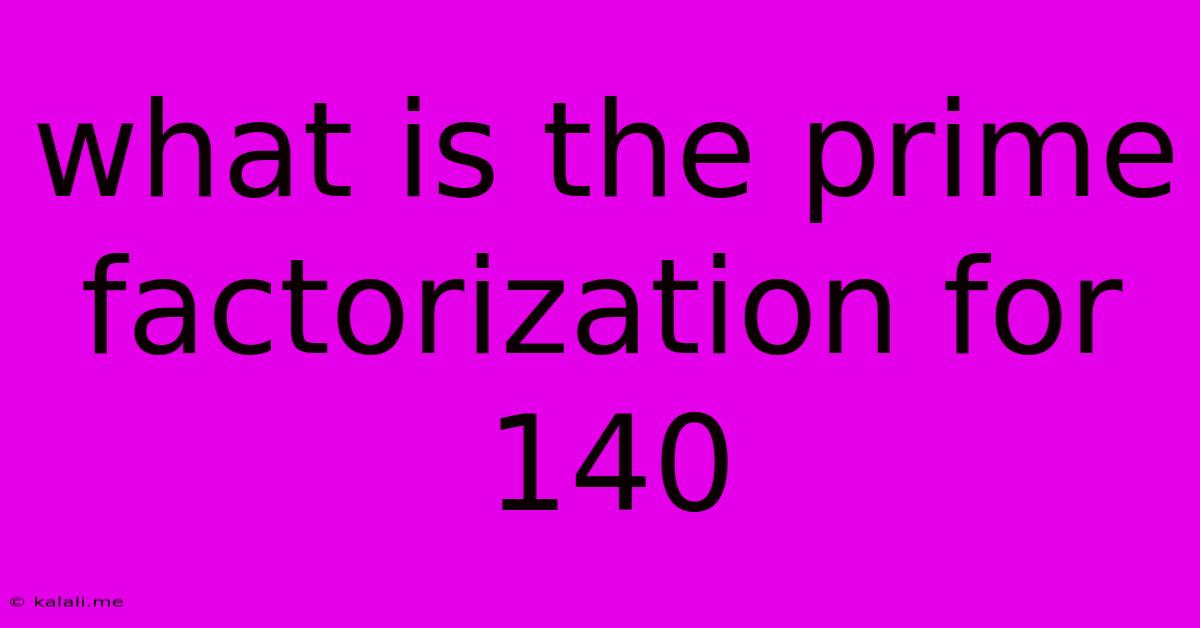What Is The Prime Factorization For 140
Kalali
May 09, 2025 · 3 min read

Table of Contents
What is the Prime Factorization for 140? A Step-by-Step Guide
Finding the prime factorization of a number is a fundamental concept in mathematics, particularly useful in simplifying fractions, understanding number properties, and solving various mathematical problems. This article will guide you through the process of determining the prime factorization of 140, explaining the method clearly and concisely. Learn how to break down a number into its prime components, a crucial skill for anyone studying number theory or algebra.
What is Prime Factorization?
Prime factorization involves expressing a composite number (a number greater than 1 that has more than two factors) as a product of its prime factors. A prime number is a whole number greater than 1 that has only two divisors: 1 and itself. Examples of prime numbers include 2, 3, 5, 7, 11, and so on. The process of finding these prime factors helps us understand the building blocks of the composite number.
Finding the Prime Factors of 140
We can use a factor tree to visualize the process of prime factorization. Here's how to find the prime factorization of 140:
-
Start with the smallest prime number: Begin by dividing 140 by the smallest prime number, which is 2. 140 divided by 2 equals 70.
-
Continue dividing by prime numbers: Now, we continue to divide 70 by the smallest prime number possible. 70 divided by 2 equals 35.
-
Find the next prime factor: Notice that 35 is no longer divisible by 2. The next smallest prime number is 3, but 35 isn't divisible by 3. However, 35 is divisible by 5 (another prime number). 35 divided by 5 equals 7.
-
The final prime factor: 7 is also a prime number, so we've reached the end of our factorization.
Therefore, the prime factorization of 140 is 2 x 2 x 5 x 7, or 2² x 5 x 7. This means that 140 can only be expressed as the product of these prime numbers.
Alternative Methods
While the factor tree method is visually helpful, you can also use a method of repeated division. You successively divide the number by prime numbers until you reach 1.
Applications of Prime Factorization
Understanding prime factorization has numerous applications, including:
- Simplifying fractions: Finding the greatest common divisor (GCD) of the numerator and denominator of a fraction relies on prime factorization.
- Least common multiple (LCM): Determining the LCM of numbers is easier when you know their prime factorizations.
- Cryptography: Prime numbers play a crucial role in modern cryptography, securing online transactions and data.
- Number theory: Prime factorization is a core concept in number theory, which studies the properties of numbers.
This comprehensive guide has shown you how to find the prime factorization of 140 using a clear, step-by-step approach. Mastering prime factorization is a valuable skill for anyone interested in mathematics and its applications. Now you can confidently tackle similar problems and apply this knowledge to more complex mathematical scenarios.
Latest Posts
Latest Posts
-
What Percent Of 28 Is 14
May 09, 2025
-
In Salt Water What Is The Solute
May 09, 2025
-
4 Indicators Of A Chemical Reaction
May 09, 2025
-
How Many Cups Of Water Equals 4 Quarts
May 09, 2025
-
170 Out Of 200 Is What Percent
May 09, 2025
Related Post
Thank you for visiting our website which covers about What Is The Prime Factorization For 140 . We hope the information provided has been useful to you. Feel free to contact us if you have any questions or need further assistance. See you next time and don't miss to bookmark.